To start making your own perfumes, you'll need essential equipment including a high-precision digital scale (0.01g accuracy), glass beakers, disposable pipettes, and amber bottles for storage. Don't forget safety gear like nitrile gloves and protective eyewear. Your workspace should be well-ventilated and equipped with clean surfaces, storage shelves, and fragrance test strips. With these basic tools in place, you're ready to discover the secrets of professional perfume creation.
Essential Blending Equipment for Your First Perfume
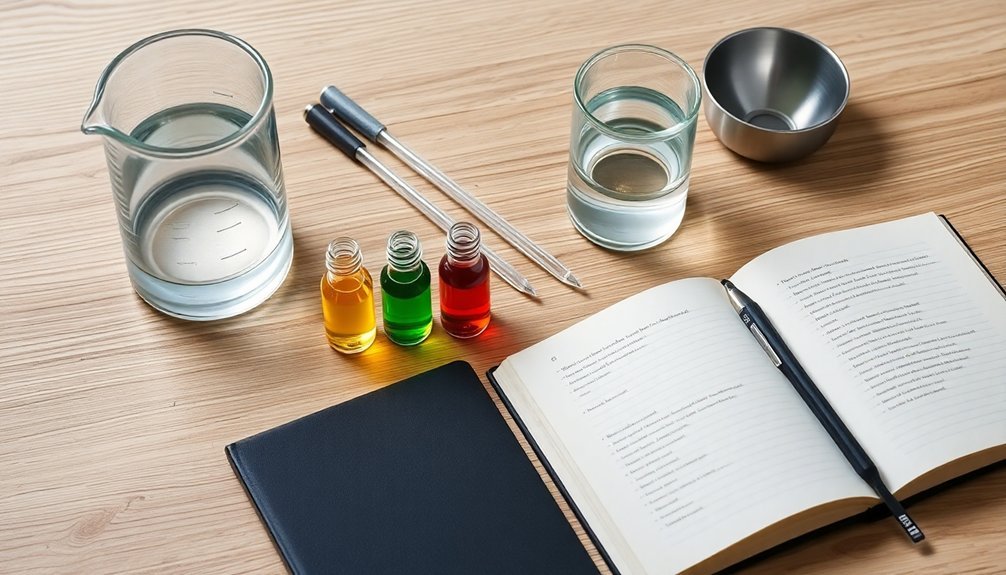
Three fundamental categories of equipment form the backbone of DIY perfume making: measuring tools, blending apparatus, and storage containers.
For your first perfume project, you'll need precise measuring instruments to guarantee consistent results. Start with an analytical balance that measures to 0.001g precision, along with measuring droppers for your essential oils. You'll also want graduated glass beakers for accurate liquid measurements. Expect to invest between $100-150 for a quality scale with the right specifications.
For the blending process, gather non-reactive glass or ceramic bowls and mixing rods. Don't forget your glass funnel and filter paper to remove any sediments.
As you blend, you'll need amber or dark glass bottles to protect your oils from light exposure, plus some perfume tester strips to evaluate your creations.
Keep a record book nearby to document your formulations and adjustments.
Safety Gear to Protect Yourself While Creating
Safety should be your top priority when crafting perfumes, as many fragrance materials can irritate skin and eyes.
Start by equipping yourself with nitrile gloves to protect your hands and safety goggles to shield your eyes from accidental splashes.
You'll need to cover your workspace with protective material and wear old clothes or an apron to guard against stains.
Make sure you're working in a well-ventilated area to avoid inhaling strong fragrances. Keep a first aid kit nearby for emergencies.
Before working with any new ingredients, conduct patch tests to check for potential allergic reactions.
A reliable digital scale is essential for accurately measuring and recording your fragrance oil percentages.
Label all your materials clearly and maintain a clean, organized workspace.
Store your fragrances properly in dark, cool places using secure bottles to prevent leaks and preserve their quality.
Precision Tools for Accurate Measurements
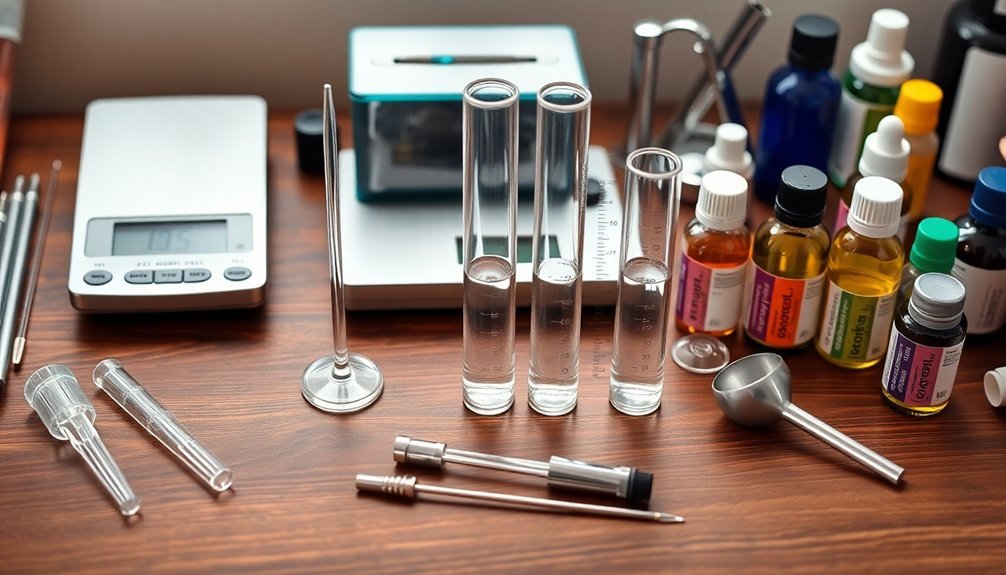
With your safety equipment ready, let's focus on the tools that'll help you create precise perfume formulations.
You'll need accurate measuring tools to guarantee your fragrances are consistent and replicable. A high-precision digital scale is your most important tool, ideally measuring down to 0.01g.
While droppers and pipettes can help transfer small quantities, you'll want to record all measurements by weight for scalability. Glass measuring cylinders, beakers, and funnels will help you handle and filter your liquid ingredients properly. Always ensure your equipment is sterilized with ethanol before starting any new perfume blend.
Essential measuring tools for perfume making:
- Digital scale with 0.01g precision
- Glass measuring cylinders and beakers
- Disposable plastic pipettes
- Glass funnels for filtering
- Mixing pots with screw-on caps
Remember to maintain a detailed record of weights and percentages rather than drops, as this'll guarantee your formulas remain consistent when scaling up production.
Storage Solutions and Bottle Selection
Proper storage and bottle selection play essential roles in preserving your handcrafted perfumes and establishing your brand identity. Store your creations in cool, dark places away from direct sunlight, using drawers, cabinets, or mini fridges to maintain consistent temperatures.
You'll find that organized storage solutions like trays, drawer dividers, or spinning stands help keep your perfumes accessible while protecting them from degradation.
When selecting bottles, consider both functionality and aesthetics. Choose sizes that match your intended use: small bottles (1.5-30ml) for travel, medium ones (50-100ml) for daily wear, or large formats (125-250ml) for luxury editions.
Remember that perfumes typically last 3-5 years, so factor in shelf life when deciding on bottle sizes. The bottle's shape, material, and finish should align with your brand's personality, whether it's minimalist or luxurious.
Must-Have Base and Fragrance Oils

You'll need carrier oils as the foundation of your perfume-making journey, with jojoba, sweet almond, and fractionated coconut oil serving as excellent starting options.
These base oils work perfectly to dilute and carry your fragrance oils while offering beneficial properties for your skin.
When selecting your top fragrance notes, consider blending citrus options like bergamot and mandarin with floral scents to create unique combinations that reflect your personal style.
Essential Carrier Oils Guide
Five essential carrier oils form the foundation of successful DIY perfume making: jojoba, sweet almond, fractionated coconut, grapeseed, and apricot kernel oil. Each offers unique properties that'll enhance your perfume's quality and longevity. Your choice of carrier oil affects how your fragrance develops and lasts on your skin.
- Jojoba oil mimics your skin's natural oils, making it perfect for all skin types while maintaining scent integrity.
- Sweet almond oil absorbs quickly and works beautifully with delicate fragrances.
- Fractionated coconut oil blends easily and stays liquid at any temperature.
- Grapeseed oil's neutral scent won't compete with your essential oils.
- Apricot kernel oil's silky texture creates luxurious evening perfumes that reveal scent layers gradually.
When blending, start with 15-30 drops of essential oil per ounce of carrier oil, adjusting to achieve your desired strength.
Blending Top Fragrance Notes
Building on your carrier oil foundation, successful perfume making requires understanding the layered approach of fragrance notes.
When working with top notes, you'll need essential oils that provide immediate impact, like bergamot, lemon, or neroli. These create your fragrance's first impression and set the stage for the entire composition.
You'll want to add your top notes last in the blending process, after you've established your base and heart notes. This guarantees proper integration with the deeper, longer-lasting elements of your perfume.
Remember to balance these lighter scents carefully – they'll evaporate quickly but must harmonize with the heart notes like rose or jasmine, and base notes such as cedarwood or vanilla.
Start with small amounts and adjust gradually until you achieve the desired initial burst of fragrance.
Workspace Setup and Ventilation Requirements
Your perfume-making workspace needs proper ventilation with an exhaust fan to maintain air quality and protect your health while working with fragrances.
Keep your work surface non-reactive and clutter-free, with essential tools like scales, glassware, and scent strips arranged within easy reach.
You'll want to organize raw materials in sealed cabinets and use dedicated racks for current projects to create an efficient workflow that minimizes fragrance cross-contamination.
Airflow and Safety Basics
Proper airflow and safety measures serve as the foundation for any DIY perfume workspace.
You'll need to maintain at least 6 air changes per hour or 1 CFM per square foot to keep vapor concentrations at safe levels. Install an exhaust fan and keep windows open when working with fragrances to guarantee proper ventilation.
Your essential safety checklist should include:
- Nitrile or latex gloves to protect your hands from chemicals
- Safety goggles to shield your eyes from splashes
- A face mask or respirator for fume protection
- A bell jar for containing fragrance vapors during testing
- A well-maintained ventilation system
Don't forget to store your materials in closed cabinets and carefully label all containers.
Working in an enclosed space with poor air circulation can be dangerous, so always prioritize proper airflow in your workspace.
Clean Workspace Organization Tips
While setting up a DIY perfume workspace requires careful planning, organizing your space efficiently will help prevent cross-contamination and guarantee consistent results. Position your perfumery scale at the center of your workstation, and arrange your storage shelves behind your desk for easy access to materials.
| Area | Essential Items | Organization Tips |
|---|---|---|
| Desk | Scale, pipettes | Keep centerpiece clear |
| Storage | Raw ingredients | Arrange alphabetically |
| Ventilation | Fans, windows | Maintain air circulation |
| Materials | Alcohol, bottles | Store within arm's reach |
| Tools | Scent strips, racks | Use dedicated holders |
You'll need proper ventilation to avoid fragrance vapor buildup. Open windows when possible and use fans to maintain fresh air circulation. Keep your workspace away from areas with strong odors, and regularly clean all surfaces to prevent contamination. Remember to label everything clearly and utilize vertical space for maximum efficiency.
Equipment Layout Guidelines
Building on the principles of workspace organization, an effective equipment layout maximizes both safety and efficiency in your perfume-making station.
You'll need to strategically position your equipment and guarantee proper ventilation to create a functional workspace that protects your health and enhances your creative process.
- Set up your dedicated worktable with a non-reactive surface near a window or ventilation source
- Install an exhaust fan above your workspace to manage air quality and minimize fragrant "noise"
- Arrange your storage cabinets with glass doors within arm's reach for easy access to materials
- Position your scent strip holders and measuring equipment on the dominant side of your workspace
- Create a designated "ventilation zone" where you'll handle your most potent ingredients
Remember to keep windows and doors open while working to maintain consistent airflow throughout your perfume-making area.
Testing and Evaluation Tools
To create successful perfumes, you'll need reliable testing and evaluation tools that help assess fragrance compositions accurately. Start with fragrance test strips, which measure 5" x 1⁄2" and are made from pH-neutral materials. These strips let you evaluate the top, middle, and base notes of your creations.
For spray formulations, use aerosol blotters that provide a larger 5" x 3" surface area.
When testing, write the fragrance name on the non-absorbent end, bend the strip for easy handling, and apply your scent using spray, droplet, or dip methods. Hold the strip about an inch from your nose and fan it gently.
Remember to take breaks between testing different fragrances, as your nose can become desensitized. Always work in a well-ventilated area and maintain a clear labeling system for accurate evaluation.
Frequently Asked Questions
How Long Does Homemade Perfume Typically Last Before the Scent Fades?
Your homemade perfume's scent will typically last 3-5 years when stored properly. The fragrance's staying power depends on your skin type, the oil concentration, and whether you're using alcohol-based or oil-based formulas.
Can I Use Regular Vodka Instead of Perfumer's Alcohol?
You shouldn't use vodka for perfume making. It has too much water and impurities that'll prevent essential oils from dissolving properly. Instead, use perfumer's alcohol or high-proof alternatives like Everclear for better results.
What's the Ideal Temperature Range for Storing Perfume-Making Ingredients?
You'll want to store your perfume ingredients between 12-22°C (54-72°F). Don't let them get too hot or cold. Keep them at a steady temperature to protect their quality and prevent degradation.
How Do You Clean and Sterilize Perfume-Making Equipment Between Uses?
You'll want to clean your equipment with isopropyl alcohol, soapy water, or vinegar solution. Let items air-dry completely upside down. Always rinse thoroughly between methods to guarantee no cleaning residue remains.
Which Essential Oils Should Never Be Mixed Together?
You shouldn't mix mint with eucalyptus, citrus with cinnamon, or bergamot with lemon. These combinations can cause skin irritation, breathing problems, and increased photosensitivity when exposed to sunlight.
In Summary
Start your perfume-making journey with these basic tools and you'll be well-equipped to create your signature scents. Remember to prioritize safety gear and proper ventilation while working with fragrance materials. Keep your workspace organized, maintain precise measurements, and don't forget to document your creations. With these essentials in place, you're ready to explore the fascinating world of DIY perfumery.

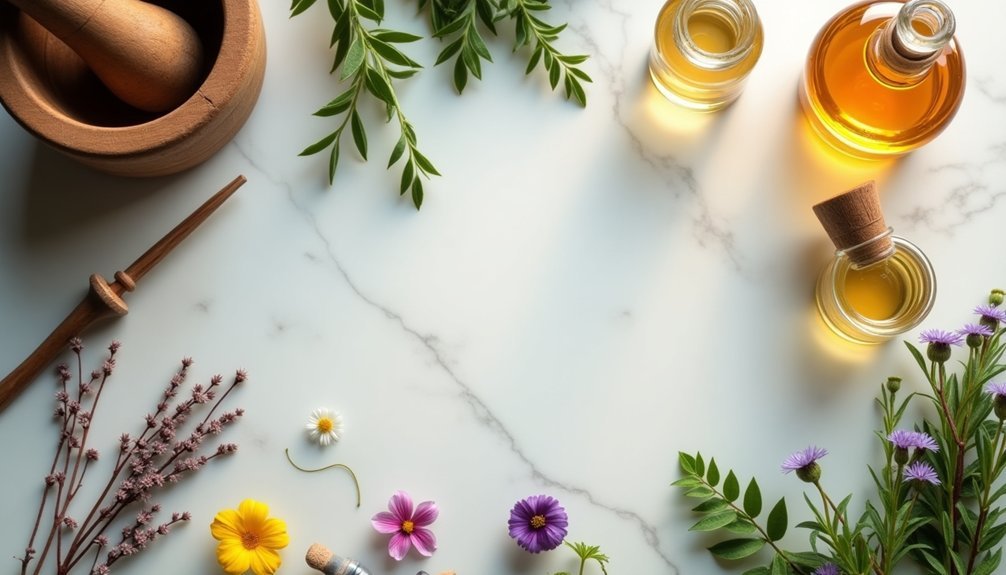
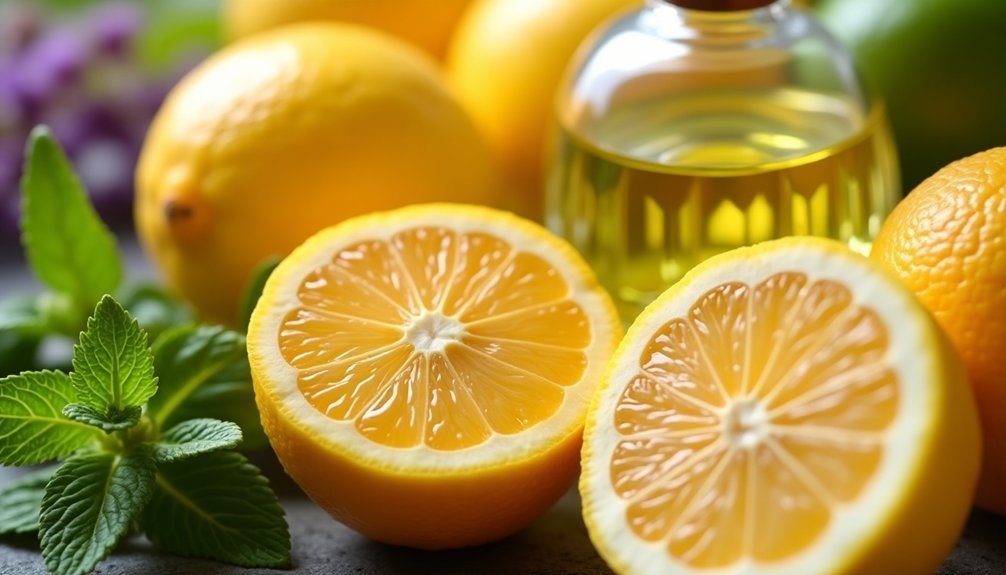
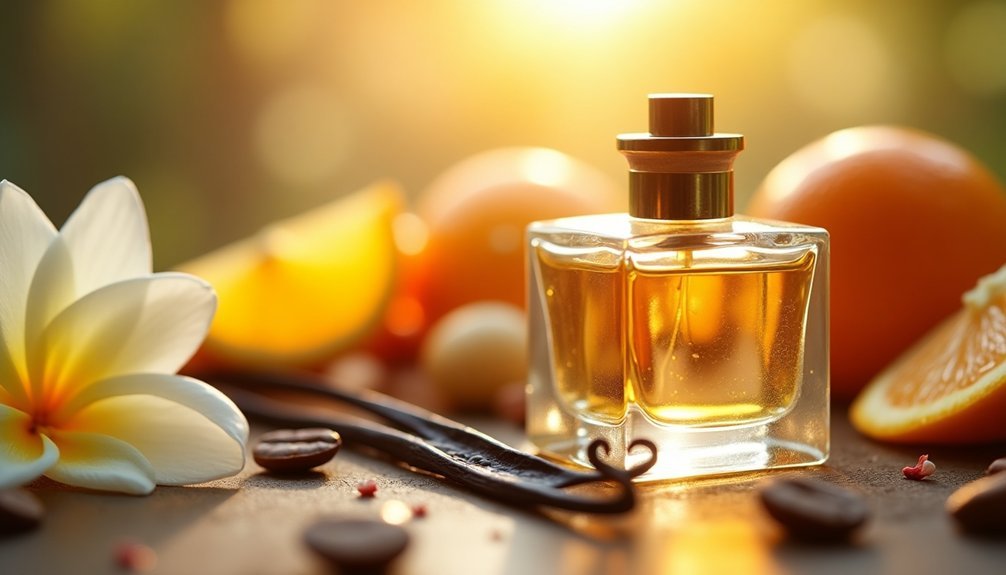

Leave a Reply